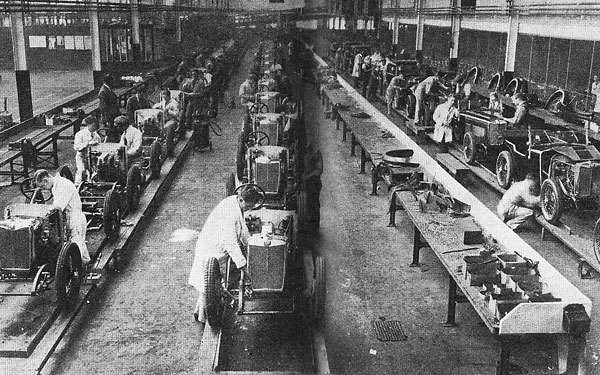October 4, 2016
Ransom E. Olds: Drawing the line

Few people know the name of the person who was awarded the very first United States patent for automobile carriages. Even fewer people know that this person was also responsible for a number of other patents and inventions, such as a chair, the gasoline engine, trucks, and tractors. He invented two automobiles, ran two companies, and had a city named after him.1 The name Henry Ford probably pops into your head. However, the person responsible for these various patents and accomplishments is Mr. Ransom Eli Olds. Olds, a victim to the sands of time, is remembered by only a few, even though he is credited for having some of the most impactful ideas for the automotive industry.

Ransom E. Olds was born June 3, 1864 to a blacksmith (Pliny Fiske Olds) and a pattern-maker (Sarah Whipple Olds) in Geneva, Ohio. By 1880, his father established a machine shop in Lansing, Michigan, and so it was there that the Olds’ roots were planted.2 Like many of the innovators of the 21st century, Old’s only had a formal education up to high school (technically having dropped out at age 16).3 His education, however, did not impede his dexterous abilities. He went to work for his father after dropping out. His father welcomed him in and even encouraged his tinkering with the machines.4 From the onset, Olds had a vision of a horseless carriage. After working for his father for two years (without pay), his tinkering finally paid off with his first steam-powered engine. Impressed by his son’s creation, Olds’ father began paying him fifty cents a day. After noting how impressive the steam engine was, however, his pay was quadrupled to two dollars a day.5

Old’s purchased a half-share in his father’s business and rebranded it to P.F. Olds & Son.6 Olds’ successes continued, and in 1893, his steam powered horseless carriage became the first American automobile exported to India.7 In 1897, following the immense success of his engine, and only a year after his patent was accepted, Olds founded Olds Motor Vehicle Company to begin manufacturing some of the first steam-powered engines, by method of gasoline. Two years later he sold a large share of his company and it was renamed to Olds Motor Works and relocated to Detroit to begin mass producing the Curved Dash Oldsmobile.8. The Curved Dash Oldsmobile would go on to be one the first commercially available vehicle for the mass market. Starting at just $650 it was this price point that allowed accessibility for citizens of various backgrounds to purchase them.9 One of the reasons it was so cheap to the consumer was because it was being built through an assembly line, the first of its kind.

Ransom E. Olds, not Ford, was the pioneer of the assembly line.10 It allowed for huge workloads to be broken down into various smaller tasks. Apart from cost reductions, it also provided a more efficient work environment. The assembly line led to faster production too. More and more products could be sold at a faster rate and reduced cost. The assembly line paired with industrialization was the catalyst that turned our nation from agriculture towards the modern day machine-driven world we know today. Much thanks is due to Ransom E. Olds, the creator of the assembly line.
- George S. May, R. E. Olds: Auto Industry Pioneer (Ann Arbor: Michigan State University, 1979), 363-365. ↵
- Encyclopedia of the History of American Management, 2006, s.v. “Olds, Ransom Eli” by Morgen Witzel. ↵
- Encyclopedia of the History of American Management, 2006, s.v. “Olds, Ransom Eli” by Morgen Witzel. ↵
- May, R. E. Olds, 16, 41. ↵
- Bill Vossler, “Man of Vision: Manufacturer Ransom E. Olds Left Lasting Imprint on Early Automotive Industry,” Farm Collector (2012). ↵
- Bill Vossler, “Man of Vision: Manufacturer Ransom E. Olds Left Lasting Imprint on Early Automotive Industry,” Farm Collector (2012). ↵
- May, R. E. Olds, 186. ↵
- “Ransom E. Olds,” R.E. Olds Foundation, September 30, 2011, http://www.reoldsfoundation.org/ransom-e-olds ↵
- Charles H. Hindersman, Harold W. Fox, and George Fisk, “History and Trends,” Journal of Marketing 28, no. 3 (July 1964): 103. ↵
- May, R. E. Olds, 7, 192, 363. ↵
Tags from the story
Oldsmobile
Ransom E. Olds